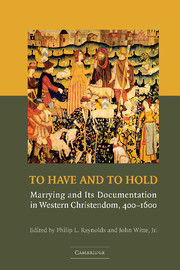Book contents
- Frontmatter
- Contents
- List of Contributors
- Preface and Acknowledgments
- List of Abbreviations
- 1 Marrying and Its Documentation in Pre-Modern Europe: Consent, Celebration, and Property
- 2 Marrying and Its Documentation in Later Roman Law
- 3 Marrying and the Tabulae Nuptiales in Roman North Africa from Tertullian to Augustine
- 4 Dotal Charters in the Frankish Tradition
- 5 Marriage and Diplomatics: Five Dower Charters from the Regions of Laon and Soissons, 1163–1181
- 6 Marriage Agreements from Twelfth-Century Southern France
- 7 Marriage Contracts in Medieval England
- 8 Marriage Contracts and the Church Courts of Fourteenth-Century England
- 9 Marrying and Marriage Litigation in Medieval Ireland
- 10 Marriage Contracts in Medieval Iceland
- 11 Contracting Marriage in Renaissance Florence
- 12 Marital Property Law as Socio-Cultural Text: The Case of Late-Medieval Douai
- 13 Marriage Contracts, Liturgies, and Properties in Reformation Geneva
- Index
2 - Marrying and Its Documentation in Later Roman Law
Published online by Cambridge University Press: 12 September 2009
- Frontmatter
- Contents
- List of Contributors
- Preface and Acknowledgments
- List of Abbreviations
- 1 Marrying and Its Documentation in Pre-Modern Europe: Consent, Celebration, and Property
- 2 Marrying and Its Documentation in Later Roman Law
- 3 Marrying and the Tabulae Nuptiales in Roman North Africa from Tertullian to Augustine
- 4 Dotal Charters in the Frankish Tradition
- 5 Marriage and Diplomatics: Five Dower Charters from the Regions of Laon and Soissons, 1163–1181
- 6 Marriage Agreements from Twelfth-Century Southern France
- 7 Marriage Contracts in Medieval England
- 8 Marriage Contracts and the Church Courts of Fourteenth-Century England
- 9 Marrying and Marriage Litigation in Medieval Ireland
- 10 Marriage Contracts in Medieval Iceland
- 11 Contracting Marriage in Renaissance Florence
- 12 Marital Property Law as Socio-Cultural Text: The Case of Late-Medieval Douai
- 13 Marriage Contracts, Liturgies, and Properties in Reformation Geneva
- Index
Summary
“Marriage is the joining of male and female and a partnership [consortium] for all of life, a sharing of divine and human law,” wrote the jurist Modestinus early in the third century. The lawyer thus expresses the Roman idea of marriage as a joint enterprise, in which each partner has both emotional and financial interests (consortium can also connote a business relationship), a view found also in literary sources. A similar but more sentimental depiction of marriage appears in funerary inscriptions for a deceased spouse, with whom the dedicator is said to have lived for years “without any complaint” (sine ulla querela), and on sarcophagi depicting the couple clasping hands in a gesture of marital solidarity. Whatever the realities of married life for individuals, Roman public and private ideology clearly espoused the idea of marriage as a mutual and balanced partnership.
It is fitting to begin with a quotation from one of the great legal minds of the imperial period, for any study of Roman marriage will of necessity draw heavily on legal evidence. The sources available to scholars of marriage in the medieval and early modern periods – cartularies, parish records, local and episcopal archives, private diaries, letter exchanges, and so on – do not exist here (apart from the epistles of famous political or religious figures, which are literary or theological works rather than intimate correspondence).
- Type
- Chapter
- Information
- To Have and to HoldMarrying and its Documentation in Western Christendom, 400–1600, pp. 43 - 94Publisher: Cambridge University PressPrint publication year: 2007
- 6
- Cited by

